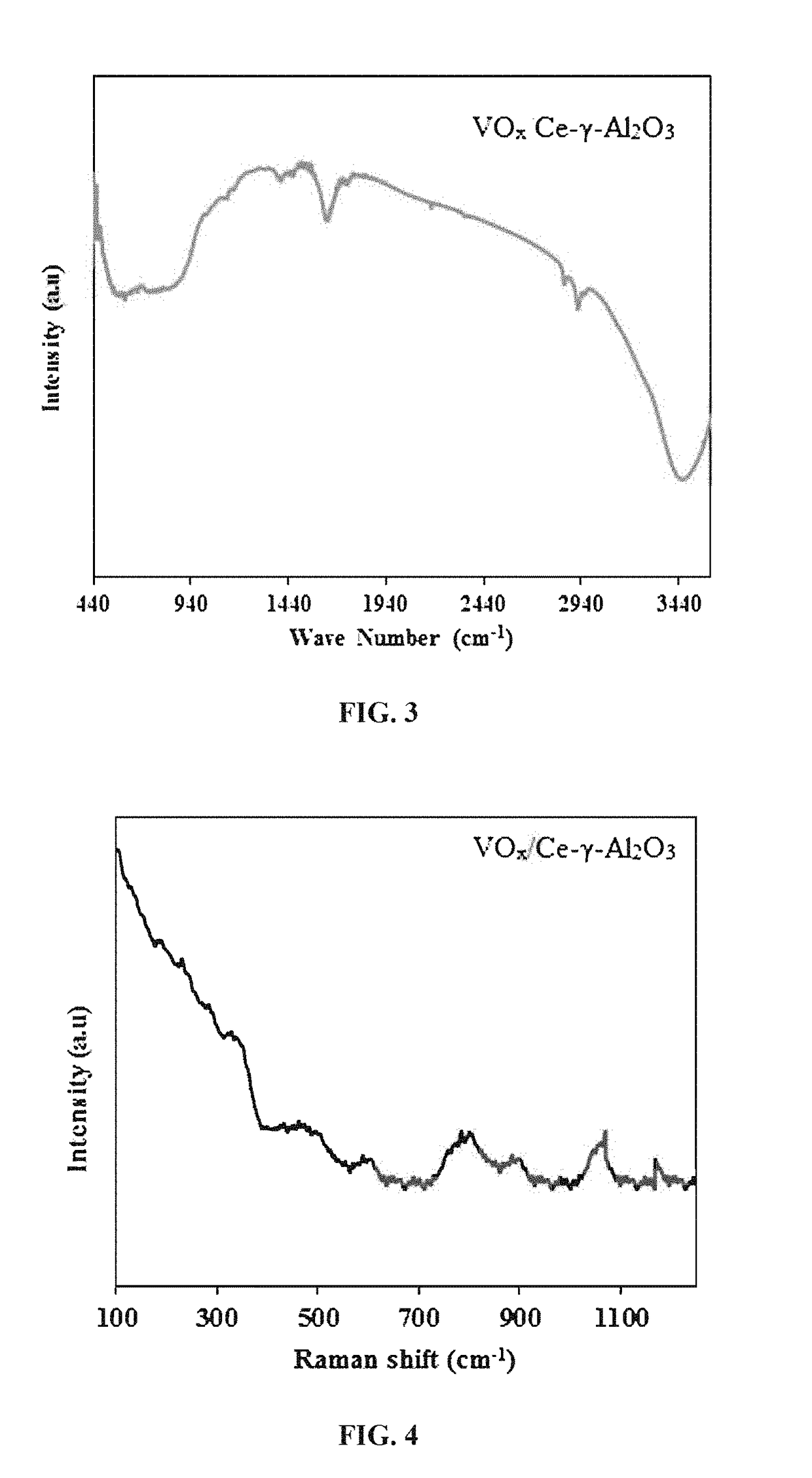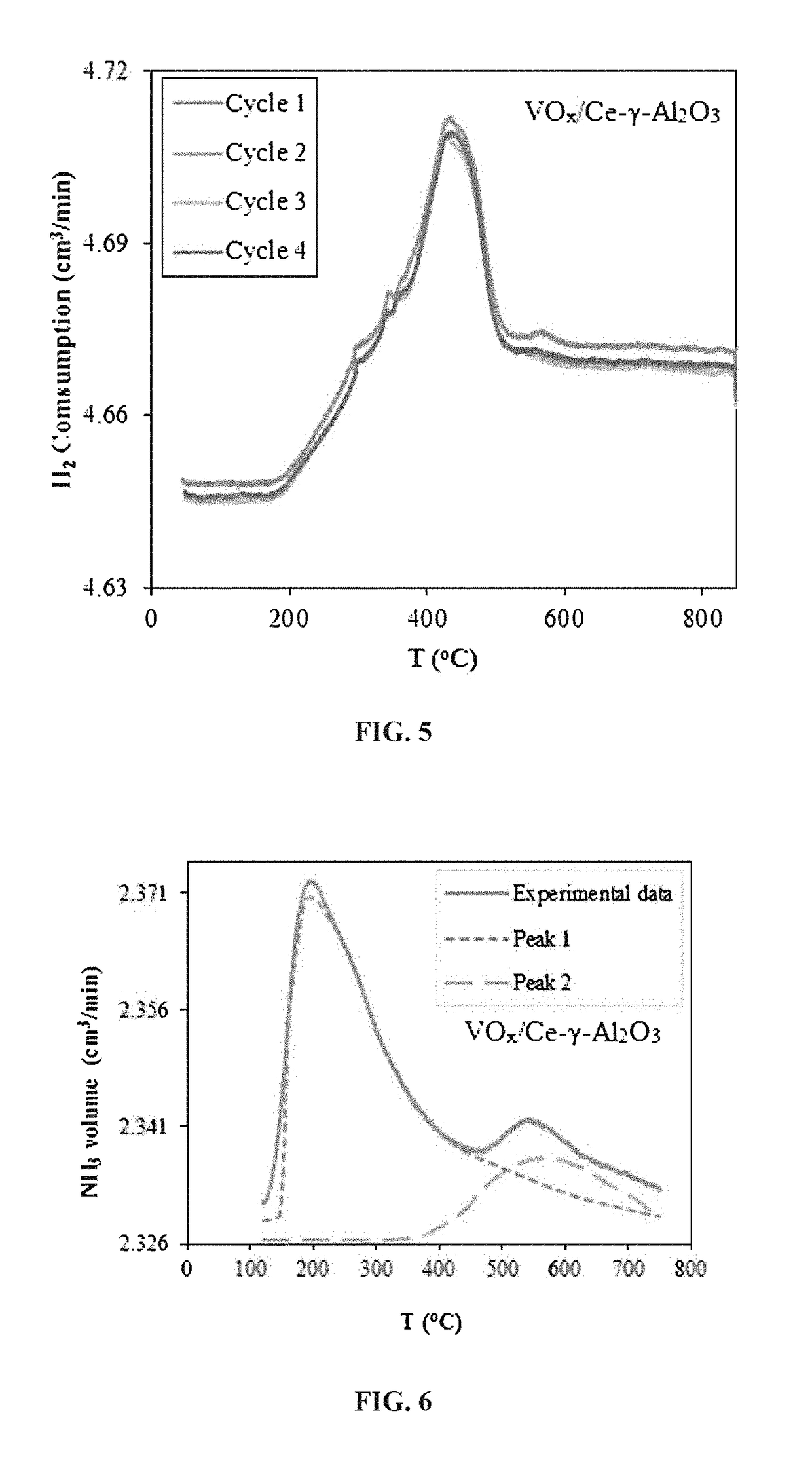Fluidizable vanadium catalyst for oxidative cracking of hydrocarbons to olefins in a gas phase oxygen free environment
a vanadium catalyst and olefin technology, applied in the field of fluidizable vanadium based vox/ceal2o3 catalysts, can solve the problems of low selectivity to olefins, high production cost of steam cracking process, and low zeolites deactivation ra
- Summary
- Abstract
- Description
- Claims
- Application Information
AI Technical Summary
Benefits of technology
Problems solved by technology
Method used
Image
Examples
example 1
Catalyst Synthesis
[0100]Aluminum nitrate nona-hydrate, cerium nitrate hexa-hydrate and vanadium acetylacetonate were obtained from Sigma-Aldrich and used without further purification. Ammonium carbonate was purchased from Fisher Limited and deionized water was used in the preparations of the chemicals. The cerium doped mesoporous γ-Al2O3 support was prepared by modifying the approaches previously presented by X. Shang, et al. and J. Wang, et al. [X. Shang, X. Wang, W. Nie, X. Guo, X. Zou, W. Ding, and X. Lu, “Facile strategy for synthesis of mesoporous crystalline γ-alumina by partially hydrolyzing aluminum nitrate solution,”J. Mater. Chem., vol. 22, no. 45, p. 23806, 2012; and J. Wang, K. Shang, Y. Guo, and W. C. Li, “Easy hydrothermal synthesis of external mesoporous γ-Al2O3 nanorods as excellent supports for Au nanoparticles in CO oxidation,”Microporous Mesoporous Mater., vol. 181, no. 3, pp. 141-145, 2013—each incorporated herein by reference in its entirety]. A surfactant free ...
example 2
X-Ray Diffraction (XRD) Analysis and Characterization of the Prepared Catalyst
[0102]The physio-chemical make-up of the different crystalline phases of the catalyst were studied by X-ray diffraction (XRD) analysis. The analysis was conducted using a Rigaku Mini-Flex II bench top XRD diffractometer. Cu-Kα monochromatic radiation (λ=0.15406 nm, 30 kV, 15 mA) over a 10-90° range at a scan rate of 3° / min and with the step size of 0.02 was used to analyze the diffraction pattern of the prepared catalyst and supports.
[0103]FIG. 2 presents the XRD patterns of the (a) VOx / Ce-γ-Al2O3 and (b) Ce—Al2O3 support samples. As can be seen, γ-Al2O3 peaks appear at 45° and 67° in both Ce-γ-Al2O3 support and VOx / Ce-γ-Al2O3 patterns [S. A. Al-ghamdi, M. M. Hossain, and H. I. De Lasa, “Kinetic Modeling of Ethane Oxidative Dehydrogenation over VOx / Al2O3 Catalyst in a Fluidized-Bed Riser Simulator,” 2013; and I. E. Wachs and B. M. Weckhuysen, “Structure and reactivity of surface vanadium oxide species on o...
example 3
Fourier Transform Infrared (FTIR) Spectroscopy Analysis and Characterization of the Prepared Catalyst
[0104]Fourier transform infrared (FTIR) spectra of the prepared samples were collected using a Nicolet 6700 Thermo Fisher Scientific instrument. For each experimental run, 3 mg of the catalyst was thoroughly mixed with 400 mg of standard KBr. The excited FTIR spectra were collected over the range of 400-4000 cm−1.
[0105]FIG. 3 presents the FTIR spectra of the VOx / Ce-γ-Al2O3 catalyst sample which shows a broad spectral band between the wavenumber 3000-3800 cm−1. The band at 1650 cm−1 corresponds to the O—H stretching frequency due to adsorbed water or a surface hydroxyl group. In addition, the band at 934 cm−1 is relevant to Al—O—V vibrations and is due to significant interaction γ-Al2O3 which confirms the presence of isolated VOx species on the surface of the support in agreement with the XRD patterns [A. M. Elfadly, A. M. Badawi, F. Z. Yehia, Y. A. Mohamed, M. A. Betiha, and A. M. Ra...
PUM
| Property | Measurement | Unit |
|---|---|---|
| Temperature | aaaaa | aaaaa |
| Temperature | aaaaa | aaaaa |
| Fraction | aaaaa | aaaaa |
Abstract
Description
Claims
Application Information
 Login to View More
Login to View More - R&D
- Intellectual Property
- Life Sciences
- Materials
- Tech Scout
- Unparalleled Data Quality
- Higher Quality Content
- 60% Fewer Hallucinations
Browse by: Latest US Patents, China's latest patents, Technical Efficacy Thesaurus, Application Domain, Technology Topic, Popular Technical Reports.
© 2025 PatSnap. All rights reserved.Legal|Privacy policy|Modern Slavery Act Transparency Statement|Sitemap|About US| Contact US: help@patsnap.com



